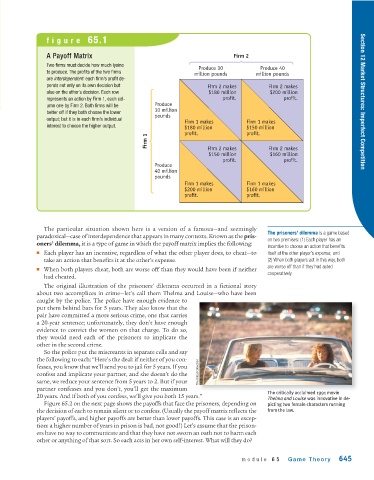Page 687 - Krugmans Economics for AP Text Book_Neat
P. 687
figure 65.1
A Payoff Matrix Firm 2
Two firms must decide how much lysine
Produce 30 Produce 40
to produce. The profits of the two firms million pounds million pounds
are interdependent: each firm’s profit de-
pends not only on its own decision but Firm 2 makes Firm 2 makes
also on the other’s decision. Each row $180 million $200 million
represents an action by Firm 1, each col- profit. profit. Section 12 Market Structures: Imperfect Competition
umn one by Firm 2. Both firms will be Produce
30 million
better off if they both choose the lower
pounds
output; but it is in each firm’s individual
Firm 1 makes Firm 1 makes
interest to choose the higher output. $180 million $150 million
profit. profit.
Firm 1
Firm 2 makes
$150 million Firm 2 makes
$160 million
profit. profit.
Produce
40 million
pounds
Firm 1 makes Firm 1 makes
$200 million $160 million
profit. profit.
The particular situation shown here is a version of a famous—and seemingly
paradoxical—case of interdependence that appears in many contexts. Known as the pris- The prisoners’ dilemma is a game based
on two premises: (1) Each player has an
oners’ dilemma, it is a type of game in which the payoff matrix implies the following:
incentive to choose an action that benefits
■ Each player has an incentive, regardless of what the other player does, to cheat—to itself at the other player’s expense; and
take an action that benefits it at the other’s expense. (2) When both players act in this way, both
■ When both players cheat, both are worse off than they would have been if neither are worse off than if they had acted
cooperatively.
had cheated.
The original illustration of the prisoners’ dilemma occurred in a fictional story
about two accomplices in crime—let’s call them Thelma and Louise—who have been
caught by the police. The police have enough evidence to
put them behind bars for 5 years. They also know that the
pair have committed a more serious crime, one that carries
a 20-year sentence; unfortunately, they don’t have enough
evidence to convict the women on that charge. To do so,
they would need each of the prisoners to implicate the
other in the second crime.
So the police put the miscreants in separate cells and say
the following to each: “Here’s the deal: if neither of you con-
fesses, you know that we’ll send you to jail for 5 years. If you
confess and implicate your partner, and she doesn’t do the The Kobal Collection
same, we reduce your sentence from 5 years to 2. But if your
partner confesses and you don’t, you’ll get the maximum The critically acclaimed 1991 movie
20 years. And if both of you confess, we’ll give you both 15 years.” Thelma and Louise was innovative in de-
Figure 65.2 on the next page shows the payoffs that face the prisoners, depending on picting two female characters running
the decision of each to remain silent or to confess. (Usually the payoff matrix reflects the from the law.
players’ payoffs, and higher payoffs are better than lower payoffs. This case is an excep-
tion: a higher number of years in prison is bad, not good!) Let’s assume that the prison-
ers have no way to communicate and that they have not sworn an oath not to harm each
other or anything of that sort. So each acts in her own self-interest. What will they do?
module 65 Game Theory 645

